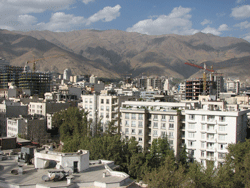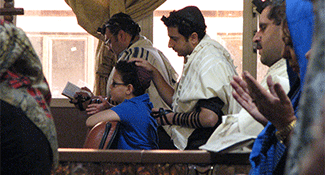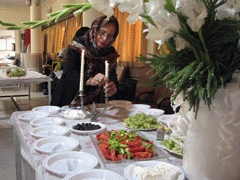Wider World
Feature
Yom Kippur in Tehran

It is just after dawn on October 2, 2014—two days before the start of Yom Kippur—and Tehran’s notoriously bad traffic is already clogging the roads, filling the air with fumes. I have been in Iran less than 12 hours, and I am now in the heart of Tehran’s Jewish community: the Abrishami Synagogue, in middle-class central Tehran.
I have been told to arrive early for the Thursday prayer service. The selihot prayers said in the period leading up to the High Holidays will be recited this morning, and the 500-seat Abrishami is nearly full. Dressed in a headscarf and manteau, a light robe covering neck to knee that all women must wear in public, I am especially pleased that the weather is kind, neither too hot nor too cold.
The Abrishami is one of an estimated 60 synagogues in Iran—and the largest of the more than 20 in Tehran. This country, which in the West is mostly associated with an oppressive government and human-rights abuses, debates over nuclear talks and terrorism, is also home to 15,000 Jews.
Iran has the oldest and largest Jewish community in the Middle East outside Israel, though the Jewish population has shrunk more than 80 percent since the 1979 revolution and the founding of the Islamic republic. Under the Islamic Constitution, Jews are an officially recognized religious minority. They elect their own deputy to parliament and have certain rights of self-administration.
Iran’s Jews are Mizrahic and Orthodox, but a relaxed version, with varying degrees of observance. It is also a population that expresses a lot of national pride. “We consider ourselves Iranian Jews, rather than Jewish Iranians,” says 41-year-old Abrishami member Farah Akbari.
Two-thirds of the Jewish community live in Tehran, mostly in the southern part of the city, and, in addition to the synagogues, run a hospital, private schools and restaurants. I came to the city driven by curiosity. I wanted to see the reality of its Jewish community and to experience a slice of Jewish life in a country effectively isolated for decades.

The community is private and tight-knit. It occupies a distinct, separate space within the larger Muslim society. For example, those outside the congregation can find it difficult to gain entry to the Abrishami as well as other synagogues. But the head of the community, introduced to me only as Mr. Shalom, made an exception for me.
I climb the synagogue’s two flights of stairs and enter the sanctuary, a low-ceilinged room with windows along the side, letting the morning light in. A few hundred members of the congregation are already praying. Men sit on one side, women on the other, divided by a short, waist-high panel. The women smile as I maneuver around groups of chairs to find an empty place with a view of the Ark. The women all wear pants, which are considered formal in Iran.
I am aware that I stand out, even more so as I scribble in my notebook—I was told that this is the only service in which I can snap photos and take notes.
As the two-hour service comes to a close, the women put down their prayer books to set two tables, one for men and one for women, for a typical Iranian breakfast. There is an open kitchen at the back from which they bring trays of hard-boiled eggs, tomatoes, cucumbers, watermelon and dates. Platters of thick, doughy sesame-topped bread; creamy feta cheese; honey; and a thin, round, sweet-tasting potato “kugel” called koukou are also placed on the tables. Everyone gathers hungrily. Children scatter after tearing off hunks of bread.

After the meal, I stay to help clean up and talk to the women about their preparations for Yom Kippur. I learn that traditional Iranian foods—lamb and chicken stews with pomegranate molasses or sumac and rice flavored with saffron—are eaten on holidays, with a few exceptions: Chickpea and minced-chicken dumplings, akin to matza balls, are served with soup every Friday night. On Sabbath mornings, before going to synagogue, families eat eggs boiled overnight together with eggplant and fried zucchini.
I had hoped for an invitation to a Yom Kippur break fast and nervously ask whether I can help anyone prepare the meal in their home before the onset of the holiday. Even the offer of an extra pair of hands does not reverse the women’s quiet cautiousness.
They are friendly, polite and warm, but the unspoken message is clear—no one wants a journalist in their home. I feel a little defeated.
In my time in Iran, neither the Jews nor the Muslims I speak with want their identities revealed (names have been changed throughout the story). Some are even nervous as I take notes. The Jewish community’s relationship with the government is complex. In general, under current Iranian president Hassan Rouhani, the community has found acceptance, especially in contrast to former president Mahmoud Ahmadinejad’s overt anti-Semitic and anti-Israel rhetoric. Rouhani’s government has allowed Jewish schools to close on Saturdays for Shabbat (Iran’s school week runs Saturday to Thursday) and allocated money to Tehran’s Jewish charity hospital. And yet, relations between Israel and Iran are tense, to say the least, which can translate into difficulties for Iran’s Jews, and human rights groups say that the community faces discrimination (see box, page 30).
Muslims view local Jews as a group shrouded in mystery. “We don’t know anything about them,” Mohammed Razvan, a shopkeeper, tells me. “I went to school with a Jewish boy, but our families didn’t socialize.”
“It wasn’t always like that,” says Maryam Kosar, a 39-year-old dentist who is Jewish. “[The community] used to mix with Muslims, but after the revolution, when Iran became an Islamic state, we turned inward. Jews who were secular became religious. Our synagogues became our social life.”
Like many Iranian women, Kosar is happy with the 1979 reversal of a ban on women wearing color; a bright, floral manteau covers her petite frame, and her blue headscarf is draped over long, dark hair, coiled at her neck. Women’s rights are another complicated issue. Women drive, own businesses, socialize in public and attend university. Yet, female freedom in Iran is narrowly defined. Women are generally banned from men’s sporting events, for example.
Jews have lived since biblical times in this land that was once Persia. For centuries, Jews thrived, living comfortable, middle- and upper-class lives among their Muslim neighbors. Then came the revolution. Strong opposition to the Shah, Mohammad Reza Pahlavi, who had ties to Israel and the United States, created an atmosphere of anti-Semitism between 1977 and 1979. By the time of the revolution, when the Shah was toppled by Shiite Muslim clerics under Grand Ayatollah Ruhollah Khomeini, the 80,000-strong community had been reduced to about 20,000. Many bank accounts were confiscated when Iran’s Jews fled to the United States or Israel. The revolution also destroyed the Iranian economy, causing more Jews to flee.
A few Muslims share anecdotes with me of playground anti-Semitism—teachers warning that Jewish children are smelly or dirty. But, I was told, that was due to revolutionary rhetoric and is no longer the case. However, Jews are largely barred from high public office. They cannot become judges or hold a high position in the military.
Sarah Mottaki, 19, who I spoke with in Los Angeles, recently moved to the city from Tehran with her parents and brother. She notes that anti-Jewish discrimination does exist in Iran today but on a subtle, nuanced level. “If you own your own business, or work in a small, private office, it’s O.K., but if you work at the university or in a civil job, it can be much more difficult,” she explains. “It’s not explicit, but Jews in public jobs, or large offices, won’t get promotions and may not get as much vacation time.”
Because of the discrimination, most Jews own their own business in the import and export fields or in retail.
On Friday morning, with Kol Nidrei looming, I am invited to the Yusef Abad Synagogue in north Tehran—one of the most beautiful synagogues in the city. Arash Yavari, a balding man in his seventies wearing a talit, stands at the door. Yavari, a longtime member of the synagogue, reaches inside his pocket, pulls out chocolates wrapped in silver foil and stuffs a few in my palm. “Welcome,” he says.
The main sanctuary is grand, far more so than the Abrishami. Upstairs in the separate women’s section the view is staggering. An elaborate mosaic of blue and green tiles covers the entire front wall surrounding the Ark. It was created in the 1960s by Aliakbar Massoodi, a well-known Muslim architect famous in Iran for designing and installing mosaics.
Friday evening, I attend the packed Kol Nidrei service at the Abrishami. I am here as an observer—my mind is racing to absorb everything I see and hear.
I find a seat amid the noisy chaos as children run up and down aisles. I have put aside all hopes of experiencing the break fast in a home. So without an agenda, I try to concentrate on the service. But, there is a surprise. For the women around me, I, rather than the rabbi, am the focus. And I, in turn, am fascinated by these beautiful, elegant women, with their smoky brown eyes and straightened noses. A little surgery, I discover, is a common procedure for all Iranians—Jews and non-Jews. One often sees women out in public with a small strip of white bandage across their noses, totally free of any self-consciousness. Around me, manes of long, straight black hair are swept under bright headscarves. They wear robes in cobalt blue, hot pink, saffron and green.
It is difficult to hear the rabbi, who also serves as the hazan, as the room has poor acoustics. Then, suddenly, a 60-something woman who does not tell me her name asks me where I am from. We begin to talk. She speaks of the optimism of the new political regime and the way Rouhani has distanced himself from his predecessor. It was Ahmadinejad’s contentious approach toward Jews, his public denial of the Holocaust, she says, that led to the sense of caution and fragility in Iran’s Jewish community.
We talk about Jews who choose to leave Iran, and those who refuse to emigrate. The latter say it is too hard to abandon families, homes, everything they know, including a language, to start over again. And, in a city like Los Angeles, where many have relatives and friends, there is simply the cost of keeping up.
“The cost of living in Iran does not even begin to compare with that of Beverly Hills,” explains Sarah Mottaki. “Many Iranians have big, beautiful homes and nice cars. If they left, they would never be able to afford the same lifestyle.”
Beyond the financial practicalities, though, it is losing face that many are concerned with. Those who stay admit that though the environment is not perfect, with their synagogues, their freedom to worship as they wish and largely being left alone, life is O.K.
Those around us are fascinated by our conversation. Golshan Pirani, a woman in her forties sitting with her two teenage daughters, listens intently. Then, without solicitation, I am invited to break the fast with them at their home in north Tehran. The fabled Iranian hospitality has revealed itself.
We turn our attention to the parade of Torah Scrolls—12 in all— carried out of the Ark. The first is clothed in iridescent sky-blue cloth, the sparkle of the stones on its mantle catching the light; another is wrapped in ivory satin embroidered with gold thread. Others are decorated with jewel-toned metalwork and gold-patterned panels.
Saturday, after a full day of fasting and praying, the Piranis and I drive 20 minutes to their apartment complex in affluent north Tehran. We are buzzed through security gates, walk across a small courtyard and through three massive, grand, dark burgundy lacquered doors before going up to my hosts’ apartment.
Once inside, Golshan and her husband, Adel, and their two daughters, 13-year-old Asal and 15-year-old Homa, quickly change into casual clothing. The lines between East and West have blurred again. Golshan looks like any Western housewife, in jeans and an over-sized pink plaid button-down—the kind you would find at any mall store. Asal and Homa are both in the typical teenage uniform of T-shirts and leggings, brandishing iPhones, desperate to swap Instagram IDs.
My eyes dart around the roomy, open living room. One side has a big television, a couple of couches and an easy chair. At the far side, a long dining table is connected to the kitchen by a half-wall, where plates are passed through. I had expected gold leaf and Persian rugs, but the décor is contemporary and comfortable. The table is set with a simple meal of hard-boiled eggs, omelets sprinkled with sugar, tomatoes, tuna, dates, homemade wine, milk, pastries and Iranian flatbread.
There’s another guest at the table, Akba Shakiba, an older, quiet Muslim man and a longtime friend of the family. He carefully pours hot water through the tea strainer in each small glass cup, filling each one halfway, then doing a second round, ensuring none of the drinks get cold before he carries them to the table.
Adel, 48, is in the garment industry; Golshan does not work. Most of their family has moved to Los Angeles. They stay in Iran, Golshan says, to look after their parents. Adel explains that he would never find a better job than his own import business. As is common among Iranian Jews of their generation, the couple had an arranged marriage. While they both are happy, they agree that their daughters will be free to choose their own partners, as long as they are Jewish and, hopefully, Iranian—although they may be Californian if Homa has her way.
We laugh a lot, everyone aware how surreal it is for a Westerner to be sitting at their table. We take group pictures, and I laugh hard when Homa asks, “You want to take a selfie?”
I had come to satisfy my curiosity about Iran and its Jewish community and to see and feel firsthand the community’s warmth and generosity.
In my time in Tehran, I have experienced the familiar and the unfamiliar, but, ultimately, the biggest surprise was that so much about our lives hardly seems different at all.
Amy Guttman is a London-based journalist covering current affairs, entrepreneurs, food and travel.







 Facebook
Facebook Instagram
Instagram Twitter
Twitter
Leave a Reply